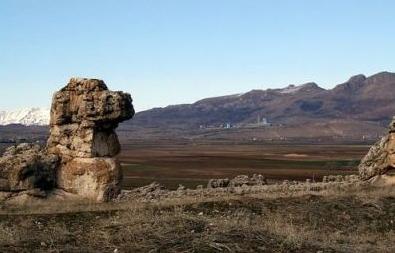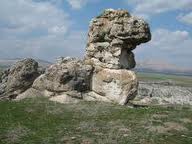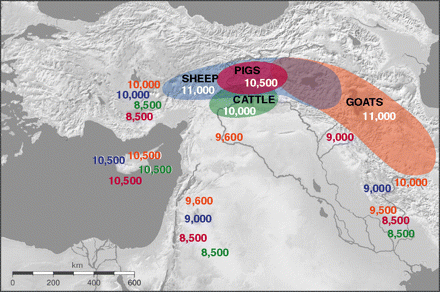It looks like you're using an Ad Blocker.
Please white-list or disable AboveTopSecret.com in your ad-blocking tool.
Thank you.
Some features of ATS will be disabled while you continue to use an ad-blocker.
share:
Originally posted by baalbuster
Good ol psilocybin! I will say that from personal experience I have never felt a larger sense of "communion" then when I ate these things.
What! More than playing a game of poker with the guys fueled with beer and chips?
Originally posted by Blackmarketeer
Beautiful site, a few potted shrubs and I wouldn't mind living there myself. Bit like Cappadocia in the same region. The rate the world's economy is going we may all be scrambling to live like this again...
Yes it's a bit cavish, I'm not sure what was found in those caves. I haven't found a non-pay version of the report yet.
Originally posted by Hanslune
Surprisingly , findings revealed a class system in social life. There was a small group of people who possessed without working and a large group of people who worked without possessing.
Hello Hanslune...I haven't read the rest of the thread yet, will do...but how is this evidenced? That is fairly unique if I am correct, at that stage. How do we know this? What did they possess?
Originally posted by Biliverdin
Originally posted by Hanslune
Surprisingly , findings revealed a class system in social life. There was a small group of people who possessed without working and a large group of people who worked without possessing.
Hello Hanslune...I haven't read the rest of the thread yet, will do...but how is this evidenced? That is fairly unique if I am correct, at that stage. How do we know this? What did they possess?
I would suspect it would be un-equal burials and materials, this is one of those 'iceberg' ideas within archaeology, simple statement by me, but years of argument and discussion on this issue.
evidence for ritual at neolithic sites
Life in Neolithic farming communities: social organization, identity
PDF on ritual beginning in the neolithic
edit on 22/2/12 by Hanslune because: Added another link
edit on 22/2/12 by Hanslune because: (no reason given)
reply to post by Hanslune
Sooo...we're not necessarily looking at possessions in life, but those in the afterlife...which could imply that they were simply valued by their society, rather than had a higher pecuniary value? Therefore perhaps not a class system, they may not have lived differently, although it could be pre-emptive, or a transitory stage towards that, but given that there is no such evidence of class systems at any of the other sites contemporary to this one...
I am wondering if the value is knowledge/skill...and therefore correlates with the domestication of animals...such knowledge would still be passed on mother to daughter/father to son (and variations there of), and so on and so forth...
Sooo...we're not necessarily looking at possessions in life, but those in the afterlife...which could imply that they were simply valued by their society, rather than had a higher pecuniary value? Therefore perhaps not a class system, they may not have lived differently, although it could be pre-emptive, or a transitory stage towards that, but given that there is no such evidence of class systems at any of the other sites contemporary to this one...
I am wondering if the value is knowledge/skill...and therefore correlates with the domestication of animals...such knowledge would still be passed on mother to daughter/father to son (and variations there of), and so on and so forth...
Originally posted by Biliverdin
reply to post by Hanslune
Sooo...we're not necessarily looking at possessions in life, but those in the afterlife...which could imply that they were simply valued by their society, rather than had a higher pecuniary value? Therefore perhaps not a class system, they may not have lived differently, although it could be pre-emptive, or a transitory stage towards that, but given that there is no such evidence of class systems at any of the other sites contemporary to this one...
I am wondering if the value is knowledge/skill...and therefore correlates with the domestication of animals...such knowledge would still be passed on mother to daughter/father to son (and variations there of), and so on and so forth...
Very hard to judge possesions during a person's life with archaeology - which is why burials are so important. If you read about 20 of these types of documents you get the feel that their was a difference but it may have been a difference between; 'why put good stuff in a hole in the ground' to 'we can potlatch all we want', type of attitudes.
I wouldn't venture beyond saying there are indications of social stratifications...and .....sounds like (in a typical digger archaeologist's patois) an anthroplogy problem
Originally posted by Hanslune
I wouldn't venture beyond saying there are indications of social stratifications...and .....sounds like (in a typical digger archaeologist's patois) an anthroplogy problem
Haha...I see your point. Thanks for at least trying to entertain my question though...I admire the patience of you archaeologists, but never could do such a thing myself...little brushes and trowels!!!...I'd be 'bring me the backhoe loader'...not good, I know.
Cheers.
edit on 22-2-2012 by Biliverdin because: (no reason given)
Originally posted by Maponos
Interesting stuff, thanks for posting
Some believe the Garden of Eden was in fact in Turkey
www.dailymail.co.uk...
This site is 60 miles from yours, a quote from the article
"The first is its staggering age. Carbon-dating shows that the complex is at least 12,000 years old, maybe even 13,000 years old.
That means it was built around 10,000BC. By comparison, Stonehenge was built in 3,000 BC and the pyramids of Giza in 2,500 BC."
I'm a firm believer that human civilization is much older than most EAA's (Establishment Academic Authorities) would consider possible. As more and more ancient artifacts are uncovered (or recognized -- I think some artifacts may have already surfaced, but we have not recognized their real age or use), I think the timeline will be pushed back further & further.
In any case, a good OP. S&F
reply to post by Maponos
The children of Eden - Or, "the Beni-Eden," who appear from the Assyrian inscriptions to have inhabited the country on the east bank of the Euphrates, about the modern Balis. Here they had a city called Beth-Adina, taken by the Assyrians about 880 B.C. This is probably the "Eden" of marginal reference. link
Some believe the Garden of Eden was in fact in Turkey
The children of Eden - Or, "the Beni-Eden," who appear from the Assyrian inscriptions to have inhabited the country on the east bank of the Euphrates, about the modern Balis. Here they had a city called Beth-Adina, taken by the Assyrians about 880 B.C. This is probably the "Eden" of marginal reference. link
Originally posted by Biliverdin
Originally posted by Hanslune
I wouldn't venture beyond saying there are indications of social stratifications...and .....sounds like (in a typical digger archaeologist's patois) an anthroplogy problem
Haha...I see your point. Thanks for at least trying to entertain my question though...I admire the patience of you archaeologists, but never could do such a thing myself...little brushes and trowels!!!...I'd be 'bring me the backhoe loader'...not good, I know.
Cheers.
Yep that part of it bored me to tears which is why I went from Professional to amateur and took up another career
Did get to use a bulldozer once when we thought a mound was going to be destroyed for a new road, we cleared off the top - shooting to save the bronze age stuff and the day afterwards the municipal government changed it mind on the matter - just a small mound about 5 meters in diameter. Did shift thru the bulldozed material and found nothing of critical importance (phew)
edit on 22/2/12 by Hanslune because: (no reason given)
Originally posted by Hanslune
Yes this site was built in the same region as Gobekli Tepe; I'm doing a 'series' of the excavation that are in that area and closest in time; I did Nevalli Cori earlier
Link to Nevelli Cori
These are all located at the 'apex' of the fertile crescent and is probably the place and time where domestication of plants, animals and life-style resulted in mankind settling down and developing the agricultural/pastoral life that led to the first cities/nations
In that case I really look forward to reading your thread on Gobekli Tepe! i wonder whether the statues were not representations of humans/gods but representations of Tau
en.wikipedia.org...
aka the
"golden ration" in mathematics and many other things in other fields
en.wikipedia.org...
I also came across a reference to a photgraph of a sphnyx in that region too, statuestque I think but in the style of Egypt none the less, as we know tau was important in ancient Egypt, and perhaps the inspiration for the cross in various religions. So kind of god tau figures. Id really like to see that Sphynx though
Originally posted by Maponos
In that case I really look forward to reading your thread on Gobekli Tepe! i wonder whether the statues were not representations of humans/gods but representations of Tau
I'm doing the lesser known sites in the same area as GT others have done a number of threads on GT
I also came across a reference to a photgraph of a sphnyx in that region too, statuestque I think but in the style of Egypt none the less, as we know tau was important in ancient Egypt, and perhaps the inspiration for the cross in various religions. So kind of god tau figures. Id really like to see that Sphynx though
It is associated with the Cayonu site


great thread, i can totally imagine us being like mice in the early years, hiding and living in the caves to protect from wild animals, only venturing
out to gather and hunt for food. These pictures are the first i've ever seen that really look like a first kind of evolution from just living in a
cave to actually developing the area directly around you, and actually settling there, i would guess that they must have been very safe there and were
able to spend the time making the area into a proper home.
reply to post by Hanslune
Hanslune,
This is abosultely fascinating! Thank you for your share! I am a pottery nut and that ancient pottery is way too cool...All of this information and these pictures are cool! Thank you for this awesomely fascinating thread! I love learning about History!
Hanslune,
This is abosultely fascinating! Thank you for your share! I am a pottery nut and that ancient pottery is way too cool...All of this information and these pictures are cool! Thank you for this awesomely fascinating thread! I love learning about History!
The "non workers" may have been shaman
just a different kind of work.
just a different kind of work.
Originally posted by Katharos62191
reply to post by Hanslune
Hanslune,
This is abosultely fascinating! Thank you for your share! I am a pottery nut and that ancient pottery is way too cool...All of this information and these pictures are cool! Thank you for this awesomely fascinating thread! I love learning about History!
Thanks
This site is interesting as it goes thru the time when the people were pre-pottery thru the start of the pottery era
Or as they say in archaeologise
The settlement covers the periods of the Pre-Pottery Neolithic A (PPNA), the Pre-Pottery Neolithic B (PPNB), and the Pottery Neolithic (PN).
Are you talking about the two headed dude? (actually I think it is a couple) if I can find the original report there are a number of other images of what they found
Originally posted by Danbones
The "non workers" may have been shaman
just a different kind of work.
Exactly.
To the OP: Great thread and interesting content. S&F!
Originally posted by Biliverdin
reply to post by Biliverdin
Another thing...do we know whether they ate the pigs?
Sorry to repeat myself on this one Hanslune...but do you know whether the domesticated pigs were eaten? It would be interesting to know whether they were domesticated for their meat or for their more useful waste disposal and fertiliser producing capabilities in context of settlement. Though I suspect the evidence would be difficult to interpret one way or another...
Well you are a demanding one, did I once almost marry you long ago?
lol
dem pigges
image that goes along with this report showing domestication dates of the key 'farm' animals

So I would say yes, they were first hunted then domesticated - were you thinking of the tabu against pork eating?
lol
dem pigges
image that goes along with this report showing domestication dates of the key 'farm' animals

So I would say yes, they were first hunted then domesticated - were you thinking of the tabu against pork eating?
edit on 23/2/12 by Hanslune
because: (no reason given)
new topics
-
Everything Falls…
Philosophy and Metaphysics: 4 minutes ago -
Steering the Titantic from the Drydock.
US Political Madness: 3 hours ago
top topics
-
House Passes Laken Riley Act
Mainstream News: 14 hours ago, 23 flags -
What Comes After January 20th
Mainstream News: 17 hours ago, 18 flags -
Los Angeles brush fires latest: 2 blazes threaten structures, prompt evacuations
Mainstream News: 14 hours ago, 7 flags -
Hearing more ambulances lately
Medical Issues & Conspiracies: 14 hours ago, 7 flags -
Paramilitary Leaks - John Williams
Whistle Blowers and Leaked Documents: 12 hours ago, 6 flags -
Steering the Titantic from the Drydock.
US Political Madness: 3 hours ago, 5 flags -
Those stupid GRAVITE commercials
Rant: 17 hours ago, 5 flags -
The more I think about it
General Chit Chat: 15 hours ago, 4 flags -
Canada as a state .. how would it work?
General Chit Chat: 17 hours ago, 4 flags -
Some sausage, some chicken, some sauce, some onions and some garlic...and some peppers!
Food and Cooking: 13 hours ago, 3 flags
active topics
-
Canada as a state .. how would it work?
General Chit Chat • 19 • : Freeborn -
Everything Falls…
Philosophy and Metaphysics • 0 • : JJproductions -
Steering the Titantic from the Drydock.
US Political Madness • 5 • : NoCorruptionAllowed -
ILLUMINATION: Dimensions / Degrees – Da Vincis Last Supper And The Philosophers Stone
Secret Societies • 21 • : CarlLaFong -
Let's Buy Greenland
General Chit Chat • 18 • : CriticalStinker -
Meta Llama local AI system is scary good
Science & Technology • 50 • : ArMaP -
Gravitic Propulsion--What IF the US and China Really Have it?
General Conspiracies • 35 • : bastion -
-@TH3WH17ERABB17- -Q- ---TIME TO SHOW THE WORLD--- -Part- --44--
Dissecting Disinformation • 3968 • : AianawaQ1320 -
Post A Funny (T&C Friendly) Pic Part IV: The LOL awakens!
General Chit Chat • 8000 • : KrustyKrab -
Los Angeles brush fires latest: 2 blazes threaten structures, prompt evacuations
Mainstream News • 13 • : BeyondKnowledge3
